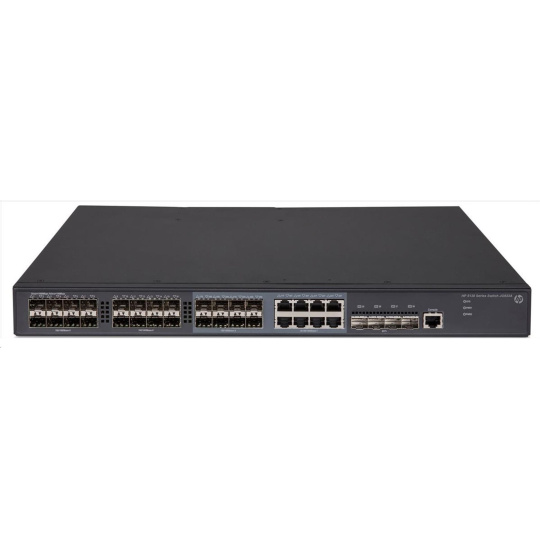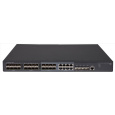HPE FlexNetwork 5130 24G SFP 4SFP+ EI Switch (Must select min 1 power supply) RENEW JG933AR
HPE FlexNetwork 5130 24G SFP 4SFP+ EI Switch (Must select min 1 power supply) RENEW JG933AR
I/O ports and slots
16 SFP 100/1000 Mbps ports
8 SFP dual-personality ports; 100/1000BaseX or 100/1000BASET RJ-45 Combo Ports
4 SFP+ fixed 1000/10000 SFP+ ports
Additional ports and slots
1 RJ-45 serial console port
Power supplies
2 power supply slots
1 minimum power supply required (ordered separately)
Physical characteristics
Dimensions
17.32(w) x 14.17(d) x 1.72(h) in (44 x 36 x 4.36 cm) (1U height)
Weight
17.64 lb (8 kg)
Memory and processor
1 GB SDRAM, 128 MB flash; packet buffer size: 1.5 MB
Mounting and enclosure
Mounts in an EIA standard 19-inch telco rack or equipment cabinet (hardware included)
Performance
1000 Mb Latency < 5 µs
10 Gbps Latency < 1.5 µs
Throughput 96 Mpps
Routing/Switching capacity 128 Gbps
Routing table size 512 entries (IPv4), 256 entries (IPv6)
MAC address table size 16384 entries
Reliability
MTBF (years) 52.79
Environment
Operating temperature 32°F to 113°F (0°C to 45°C)
Operating relative humidity 10% to 90%, noncondensing
Nonoperating/Storage temperature -40°F to 158°F (-40°C to 70°C)
Nonoperating/Storage relative humidity 5% to 95%, noncondensing
Acoustic Low-speed fan: 47.1 dB, High-speed fan: 50.7 dB; ISO 7779
Electrical characteristics
Frequency 50/60 Hz
Maximum heat dissipation 102/204 BTU/hr (107.61/215.22 kJ/hr), for AC Powered units. For DC powered units heat dissipation is 130BTU/hr min, 232BTU/hr max.
AC voltage 100 - 240 VAC
DC voltage -48 to -60 VDC
Current 5 A
Maximum power rating 60 W
Idle power 30 W
Notes
Idle power is the actual power consumption of the device with no ports connected.
Maximum power rating and maximum heat dissipation are the worst-case theoretical maximum numbers provided for planning the infrastructure with fully loaded PoE (if equipped), 100% traffic, all ports plugged in, and all modules populated.
Power Ratings for AC Power Suppply indicated above.
For DC input power, Idle Power is 38W and Max is 68W.
DC Max input current is 8A. Units are supplied without a power supply. Customer must buy 1 or 2 JD362A(AC) or JD366A (DC) power supply.
Safety
UL 60950-1; EN 60825-1 Safety of Laser Products-Part 1; EN 60825-2 Safety of Laser Products-Part 2; IEC 60950-1; CAN/CSA-C22.2 No. 60950-1; Anatel; ULAR; GOST; EN 60950-1/A11; FDA 21 CFR Subchapter J; NOM; ROHS Compliance
Emissions
EMC Directive 2004/108/EC; FCC (CFR 47, Part 15) Class A; EN 61000-4-11:2004; ANSI C63.4-2009; EN 61000-3-3:2008; VCCI V-4/2012.04; EN 6100-3-2:2006+A1:2009 + A2:2009; EN 61000-3-2:2006+A1:2009+A2:2009 ; EN 61000-4-3:2006; EN 61000-4-4:2012; EN 61000-4-5:2006; EN 61000-4-6:2009; AS/NZS CISPR 22:2009 Class A; CISPR 22:2008 Class A; EN 55022:2010 Class A; EN 61000-4-29: 2000; CISPR 24:2010; EN 300 386 V1.6.1; VCCI V-3/2013.04 Class A
Immunity
Generic EN 55024
ESD EN300 386
Management
IMC - Intelligent Management Center; command-line interface; Web browser; SNMP Manager
Services
Refer to the HP website at: www.hp.com/networking/services for details on the service-level descriptions and product numbers. For details about services and response times in your area, please contact your local HP sales office.
HPE FlexNetwork 5130 EI Switch Series
The HPE FlexNetwork 5130 EI Switch Series offers high-performance Gigabit Ethernet switches ideal for edge networking and small data center environments. These switches support static and RIP Layer 3 routing, diversified services, and IPv6 forwarding, along with four 10-Gigabit Ethernet (10GbE) uplink interfaces for enhanced connectivity.
Key Features
- Intelligent Resilient Fabric (IRF) Technology: Unifies multiple switches into one logical device, improving network resilience, performance, and availability while simplifying operations.
- Gigabit Ethernet Access: Supports reliable edge network connections and server cluster uplinks in small data centers.
- Layer 3 Routing: Static and RIP routing support for flexible and efficient network traffic management.
- IPv6 Forwarding: Ensures future-proof network readiness.
- High Availability: Designed for continuous uptime and mission-critical applications.
- Comprehensive Security: Advanced control policies to protect your network.
- Simplified Management: Streamlined operations reduce complexity and operational costs.
| HPE FlexNetwork 5130 EI Switch Series | |
| The HPE FlexNetwork 5130 EI Switch Series comprises Gigabit Ethernet switches that support static and RIP Layer 3 routing, diversified services, and IPv6 forwarding, as well as provide four 10-Gigabit Ethernet (10GbE) interfaces. Unique Intelligent Resilient Fabric (IRF) technology creates a virtual fabric by managing several switches as one logical device, which increases network resilience, performance, and availability, while reducing operational complexity. These switches provide Gigabit Ethernet access and can be used at the edge of a network or to connect server clusters in small data centers. High availability, simplified management, and comprehensive security control policies are among the key features that distinguish this series. | |
| Key features | |
| |
Standard Features
| Features and benefits |
| Software-defined networking
|
| Quality of Service (QoS)
Classifies traffic using multiple match criteria based on Layer 2, 3, and 4 information; applies QoS policies such as setting priority level and rate limit to selected traffic on a port, VLAN, or whole switch
|
| Connectivity
Simplifies deployment and dramatically reduces installation costs by helping to eliminate the time and cost involved in supplying local power at each access point location
|
| Resiliency and high availability
Creates virtual resilient switching fabrics, where two or more switches perform as a single L2 switch and L3 router; switches do not have to be co-located and can be part of a disaster-recovery system; servers or switches can be attached using standard LACP for automatic load balancing and high availability; can eliminate the need for complex protocols like Spanning Tree Protocol, Equal-Cost Multipath (ECMP), or VRRP, thereby simplifying network operation |
| Layer 3 routing
Uses a distance vector algorithm with UDP packets for route determination; supports RIPv1 and RIPv2 routing; includes loop protection |
| Management
Leverages HWTACACS to link a custom list of CLI commands to an individual network administrator's login; also provides an audit trail
Uses standard SNMP to monitor essential network functions; supports events, alarm, history, and statistics group plus a private alarm extension group
Advertises and receives management information from adjacent devices on a network, facilitating easy mapping by network management applications
Provides scalable ASIC-based wirespeed network monitoring and accounting with no impact on network performance; this allows network operators to gather a variety of sophisticated network statistics and information for capacity planning and real-time network monitoring purposes
Mirrors ingress/egress ACL-selected traffic from a switch port or VLAN to a local or remote switch port anywhere on the network
Monitors a cable between two compatible switches and shuts down the ports on both ends if the cable is broken, which prevents network problems such as loops
Provides future-proof networking because the switch is capable of being managed whether the attached network is running IPv4 or IPv6; supports pingv6, tracertv6, Telnetv6, TFTPv6, DNSv6, syslogv6, FTPv6, SNMPv6, DHCPv6, and RADIUS for IPv6
Ingress and egress port monitoring enables network problem-solving; virtual cable tests provide visibility into cable problems
Integrates fault management, element configuration, and network monitoring from a central vantage point; built-in support for third-party devices enables network administrators to centrally manage all network elements with a variety of automated tasks, including discovery, categorization, baseline configurations, and software images; the software also provides configuration comparison tools, version tracking, change alerts, and more
SNMP v1/v2c/v3, MIB-II with Traps, and RADIUS Authentication Client MIB (RFC 2618); embedded HTML management tool with secure access |
| Security
Industry-standard method of user authentication using an IEEE 802.1X supplicant on the client in conjunction with a RADIUS server
- Per-user ACLs Permits or denies user access to specific network resources based on user identity and time of day, allowing multiple types of users on the same network to access specific network services without risking network security or providing unauthorized access to sensitive data - Automatic VLAN assignment Automatically assigns users to the appropriate VLAN based on their identities
Allows secure file transfer to and from the switch; protects against unwanted file downloads or unauthorized copying of a switch configuration file
|
| Performance
Help provide high levels of security and ease of administration without impacting network performance with a feature-rich TCAM-based ACL implementation |
| Device support
|
| Convergence
Provides up to 30 W per port that allows support of the latest PoE+-capable devices such as IP phones, wireless access points, and security cameras, as well as any IEEE 802.3af-compliant end device; eliminates the cost of additional electrical cabling and circuits that would otherwise be necessary in IP phone and WLAN deployments
Supports multiple methods (automatic, IEEE 802.3af class, LLDP-MED, or user-specified) to allocate PoE power for more efficient energy savings
|
| Additional information
Improves energy efficiency through the use of the latest advances in silicon development; shuts off unused ports and utilizes variable-speed fans, reducing energy costs
Provides an easy-to-enhance-and-extend feature set, which doesn't require whole-scale changes; all switching, routing, and security platforms leverage the Comware OS, a common unified modular operating system |
| Energy Efficient Ethernet (EEE) Support Reduces power consumption in accordance with IEEE 802.3az |
| Layer 2 switching
Increase the scalability of an Ethernet network by providing a hierarchical structure; connect multiple LANs on a high-speed campus or metro network
Monitors link connectivity and shuts down ports at both ends if unidirectional traffic is detected, preventing loops in STP-based networks
|
| Layer 3 services
Determines the MAC address of another IP host in the same subnet; supports static ARPs; gratuitous ARP allows detection of duplicate IP addresses; proxy ARP allows normal ARP operation between subnets or when subnets are separated by a Layer 2 network
Simplifies the management of large IP networks; supports client; DHCP Relay enables DHCP operation across subnets
Allows UDP broadcasts to be directed across router interfaces to specific IP unicast or subnet broadcast addresses and prevents server spoofing for UDP services such as DHCP
|
| Warranty and support
See http://www.hpe.com/networking/warrantysummary for warranty and support information included with your product purchase. |
| Standards and protocols (applies to all products in series) |
| Device Management
|
| QoS/CoS
|
| General Protocols
|
| IPv6
|
| MIBs
|
| P Multicast
|
| Network Management
|
| Security
|

